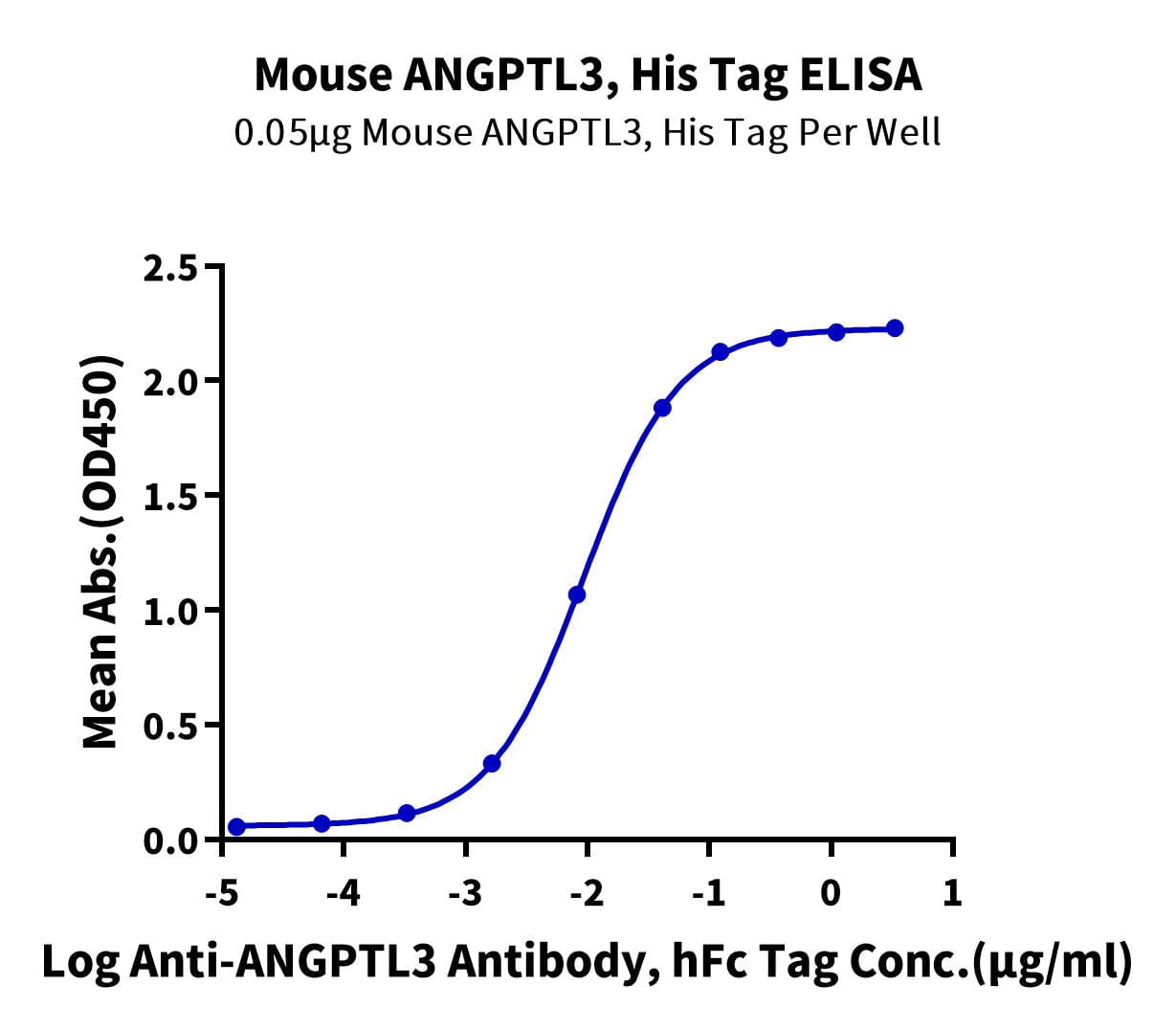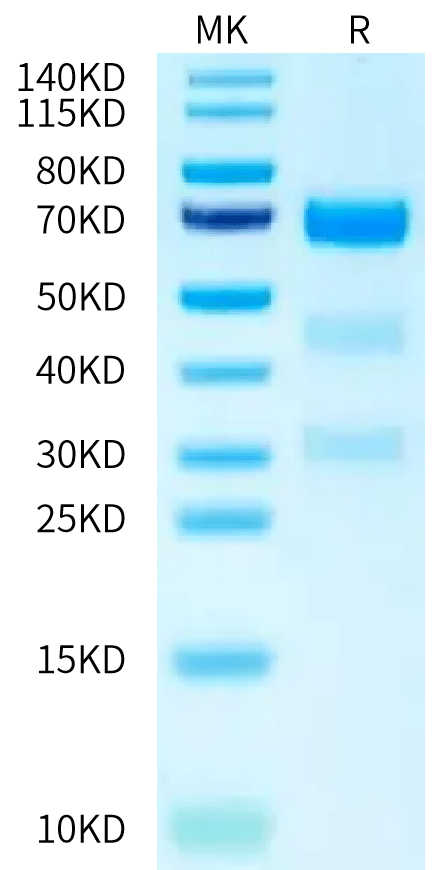| Weight | 1 lbs |
|---|---|
| Dimensions | 9 × 5 × 2 in |
| accession | Q9R182 |
| express system | HEK293 |
| product tag | C-His |
| purity | > 95% as determined by Tris-Bis PAGE |
| background | ANGPTL3 is a secreted glycoprotein that is structurally related to the angiopoietins. Mature human ANGPTL3 contains an N-terminal coiled coil domain and a C‑terminal fibrinogen-like domain. ANGPTL3 is expressed in the liver from early in development through adulthood. Acts in part as a hepatokine that is involved in regulation of lipid and glucose metabolism. Proposed to play a role in the trafficking of energy substrates to either storage or oxidative tissues in response to food intake. |
| molecular weight | The protein has a predicted MW of 51.81 kDa. Due to furin cleavage site, the protein migrates to 30-35 kDa, 43-48 kDa and 60-75 kDa based on Tris-Bis PAGE result. |
| available size | 100 µg, 500 µg |
| endotoxin | Less than 1EU per μg by the LAL method. |
Mouse ANGPTL3/Angiopoietin-like 3 Protein 2123
$270.00 – $900.00
Summary
- Expression: HEK293
- Functional: Yes (ELISA)
- Amino Acid Range: Ser17-Thr455
Mouse ANGPTL3/Angiopoietin-like 3 Protein 2123
| protein |
|---|
| Size and concentration 100, 500µg and lyophilized |
| Form Lyophilized |
| Storage Instructions Valid for 12 months from date of receipt when stored at -80°C. Recommend to aliquot the protein into smaller quantities for optimal storage. Please minimize freeze-thaw cycles. |
| Storage buffer Shipped at ambient temperature. |
| Purity > 95% as determined by Tris-Bis PAGE |
| target relevance |
|---|
| ANGPTL3 is a secreted glycoprotein that is structurally related to the angiopoietins. Mature human ANGPTL3 contains an N-terminal coiled coil domain and a C-terminal fibrinogen-like domain. ANGPTL3 is expressed in the liver from early in development through adulthood. Acts in part as a hepatokine that is involved in regulation of lipid and glucose metabolism. Proposed to play a role in the trafficking of energy substrates to either storage or oxidative tissues in response to food intake. |
| Protein names Angiopoietin-related protein 3 (Angiopoietin-like protein 3) [Cleaved into: ANGPTL3(17-224)] |
| Gene names Angptl3,Angptl3 |
| Mass 10090Da |
| Function Acts in part as a hepatokine that is involved in regulation of lipid and glucose metabolism (PubMed:11788823, PubMed:12671033). Proposed to play a role in the trafficking of energy substrates to either storage or oxidative tissues in response to food intake (PubMed:26305978). Has a stimulatory effect on plasma triglycerides (TG), which is achieved by suppressing plasma TG clearance via inhibition of LPL activity; the function seems to be specific for the feeding conditions. The inhibition of LPL activity appears to be an indirect mechanism involving recruitment of proprotein convertases PCSK6 and FURIN to LPL leading to cleavage and dissociation of LPL from the cell surface; the function does not require ANGPTL3 proteolytic cleavage but seems to be mediated by the N-terminal domain, and is not inhibited by GPIHBP1 (PubMed:12909640, PubMed:16081640, PubMed:20581395). Can inhibit endothelial lipase, causing increased plasma levels of high density lipoprotein (HDL) cholesterol and phospholipids; the cleaved N-terminal domain is more efficient than the uncleaved proprotein (PubMed:17681148). Can bind to adipocytes to activate lipolysis, releasing free fatty acids and glycerol (By similarity). Suppresses LPL specifically in oxidative tissues which is required to route very low density lipoprotein (VLDL)-TG to white adipose tissue (WAT) for storage in response to food; the function may involve cooperation with circulating, liver-derived ANGPTL8 and ANGPTL4 expression in WAT (PubMed:26305978). Contributes to lower plasma levels of low density lipoprotein (LDL)-cholesterol by a mechanism that is independent of the canonical pathway implicating APOE and LDLR (PubMed:25954050). May stimulate hypothalamic LPL activity (PubMed:25338813).; Involved in angiogenesis (PubMed:11877390). Binds to endothelial cells via integrin alpha-V/beta-3 (ITGAV:ITGB3), activates FAK, MAPK and Akt signaling pathways and induces cell adhesion and cell migration (By similarity). May increase the motility of podocytes. Secreted from podocytes, may modulate properties of glomerular endothelial cells involving integrin alpha-V/beta-3 and Akt signaling (By similarity). May induce actin filament rearrangements in podocytes implicating integrin alpha-V/beta-3 and Rac1 activation (PubMed:20633534, PubMed:24294595, PubMed:25710887). Binds to hematopoietic stem cells (HSC) and is involved in the regulation of HSC activity probably implicating down-regulation of IKZF1/IKAROS (PubMed:20959605). |
| Subellular location Secreted. Cell projection, lamellipodium. Note=Colocalized with HSPG2 and activated ITGB3 on podocytes. |
| Tissues Predominantly expressed in liver, weakly expressed in kidney and lung. Expressed in podocytes (at protein level). Expressed in hypothalamic neurons (at protein level). Expressed in bone marrow sinusoidal endothelial cells (at protein level). |
| Structure Interacts with ANGPTL8 (By similarity). Interacts with ITGB3. |
| Post-translational modification In part proteolytically cleaved by proprotein convertases; proposed to be involved in activation. In primary hepatocytes is intracellularily predominantly processed by FURIN and extracellularily by FURIN and PCSK6/PACE4. In 18.5 dpc embryos 75% of protein is found to be processed compared to 25 % in adults. |
| Domain Th |
| Target Relevance information above includes information from UniProt accession: Q9R182 |
| The UniProt Consortium |
Data
Publications
Publications
| pmid | title | authors | citation |
|---|---|---|---|
| We haven't added any publications to our database yet. | |||
Protocols
| relevant to this product |
|---|
Documents
| # | ||
|---|---|---|
| Please enter your product and batch number here to retrieve product datasheet, SDS, and QC information. | ||

















